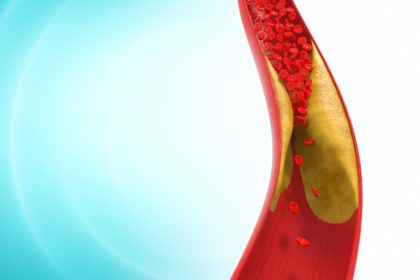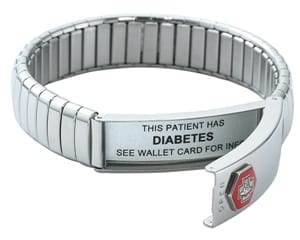Ever wonder what your blood pressure numbers mean? Here’s an explanation using a water faucet and pipe to demonstrate. And now there’s a THIRD pressure that’s important to your overall health and is worth monitoring as well.
What’s Your Pulse Pressure?
Pulse pressure is the numeric difference between systolic and diastolic blood pressure.

Predictor of Heart Attacks and Cardiovascular Disease
A resting pulse pressure in sitting position in healthy adults is about 30-40 mm Hg. For adults over age 60, especially men, a pulse pressure higher than 60 can be a useful predictor of heart attacks or other cardiovascular disease.
- A greater pulse pressure indicates that your vessels are stiffer and more damaged.
- If the aorta becomes rigid, such as from atherosclerosis, a.k.a., “hardening of the arteries”, your pulse pressure would be very high.
- Per a meta-analysis of several studies of 8,000 elderly subjects, the combined results found that a 10-point increase in pulse pressure increased the risk of major cardiovascular complications and mortality by nearly 20%.
NOTE: A low pulse pressure (i.e., 25 mm Hg or less) may mean aortic valve stenosis or congestive heart failure where a low volume of blood is ejected per beat.
Causes of Arterial Stiffness
The most important cause of an elevated pulse pressure is arterial stiffening, in particular, stiffness of the aorta (the largest artery in the body). Arteries stiffen with age, just like tissues in your skin, lungs, heart, tendons, and joints, due to:
- Degeneration of elastin fibers
- Stiffer collagen
- Fatty deposits damaging the arterial walls and resulting in them being less elastic (atherosclerosis)
Results of Arterial Stiffness
- Your heart enlarges. When arteries stiffen and lose their elasticity, your heart must contract more forcefully with each heart beat in order for your blood to circulate adequately. The extra work that your heart must perform can lead to physical changes in the musculature of your heart (e.g., size and shape), specifically the lower chambers (the ventricles). It’s just like how your biceps get bigger that occurs when you exercise them harder.
- You’re prone to irregular heart beats (cardiac arrhythmias). If the remodeling also affects the upper chambers (the atria), it can disrupt the electrical pathways that generate the signals telling your heart when to contract.
- You’re at a higher risk of a heart attack and stroke. The cause of most cardiovascular events and cerebrovascular accidents is the growth and eventual rupture of arterial plaques.
Which Is the Better Pulse Pressure?
160/120 mm Hg OR 110/70 mm Hg? (The pulse pressure in each pair = 40 mm Hg.)

Answer: 110/70
Higher systolic and diastolic pairs imply higher risk of heart attacks and heart disease
Can Atherosclerosis (Coronary Artery Disease) Be Reversed?
Atherosclerosis or “hardening of the arteries”, the buildup of fatty plaque inside your arteries, is a slow, chronic progressive disease. Some experts believe you cannot reverse plaque buildup, but you can get it to stop growing.
But according to some research, very low LDL cholesterol* levels (the “bad” cholesterol) not only stop the progression of atherosclerosis but may even REVERSE plaque buildup. Animal studies have demonstrated plaque regression with dramatic decreases in lipoprotein or cholesterol levels.
*LDL cholesterol is needed to produce hormones and provide structure to cell membranes, but because excesses can accumulate in the blood vessels and promote atherosclerosis, it’s been branded as the “bad” cholesterol.

Lifestyle Changes that Can Reduce Pulse Pressure (Arterial Plaque)
- Exercise. Aim for 30-60 minutes per day at a moderate intensity. Helps lose weight, maintain normal blood pressure, and boost “good cholesterol” (HDL) levels. HDLs are friendly scavengers that travel through your bloodstream, scrub your artery walls of harmful “bad cholesterol” (LDL), and transport them to your liver where they’re eventually eliminated.
- Dietary changes. Some evidence suggests a plant-based diet (a whole foods vegetarian diet) can reverse coronary atherosclerosis. Eat more fiber, whole grains, fruits/veggies, healthy fats. Limit sodium, sugar, and saturated fat. The formation and progression of plaque is a complex process that involves chronic systemic inflammation.
- Weight loss or healthy weight maintenance can lower your risk of complications due to atherosclerosis. A two-year study showed plaque reduction by five percent with weight loss-induced blood pressure improvements.
- High doses of cholesterol-lowering drugs. Statin drugs drive harmful LDL cholesterol to very low levels. Recent research has been used on the role of statin drugs in plaque reversal. But don’t outeat your medicine!
- No smoking.
![]() Karen’s Fit Tip: Measure your blood pressure in BOTH arms. Typically, your blood pressure is taken in the left arm, but it’s important to take it in both arms. Occasionally, the pressures will be different. A differential of 10 points or more between arms that shows up repeatedly may mean:
Karen’s Fit Tip: Measure your blood pressure in BOTH arms. Typically, your blood pressure is taken in the left arm, but it’s important to take it in both arms. Occasionally, the pressures will be different. A differential of 10 points or more between arms that shows up repeatedly may mean:
- A 38 percent greater chance of having a heart attack.
- Narrowing or blockage of the main arteries to that arm (peripheral artery disease).
- Greater risk of developing cardiovascular disease and related complications during the next 10 years.





